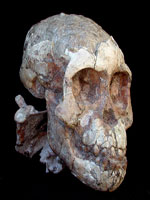WEB FOCUS
Hominid evolution and development

In this focus
Childhood is perhaps the defining feature of humanity. But how did it evolve? And when? Apart from Neanderthals, growth patterns of prehistoric humans are rarely studied because of the dearth of fossils that combine evidence from the head as well as the body. This is why the 3.3-million-year-old juvenile partial skeleton of Australopithecus afarensis -- the earliest known juvenile hominid skeleton of any kind -- is so important.
This Nature Web Focus looks at what we know about the evolution of human development, and features exclusive video interviews with the scientists behind this discovery alongside current research, features and analysis, and an archive of related palaeontological finds. Image: Zeresenay Alemseged.
Top of page
Video
Enjoy exclusive interviews with Zeresenay Alemsweged and other scientists behind the research with our special video coverage.
Top of page
Current Research
ARTICLE
A juvenile early hominin skeleton from Dikika, Ethiopia
Zeresenay Alemseged et al.
Nature 443, 296-301(21 September 2006) doi:10.1038/nature05047
Abstract | Full Text | PDF | Supplementary Information
LETTER
Geological and palaeontological context of a Pliocene juvenile hominin at Dikika, Ethiopia
Jonathan G. Wynn et al.
Nature 443, 332-336(21 September 2006) ) doi:10.1038/nature05048
NEWS AND VIEWS
Palaeoanthropology: A precious little bundle Free access
Bernard Wood
Nature 443, 278-281 (21 September 2006) doi10.1038/443278a
NEWS
Toddler hominin has arms for swinging and legs for walking. Free access
Rex Dalton
news@nature (21 September 2006) doi:10.1038/news060918-5
NEWS FEATURE
Palaeoanthropology: The history man Free access
Rex Dalton
Nature 443, 268-269 (21 September 2006) doi:10.1038/443268a
AUTHOR
Making the paper: Zeresenay Alemseged
Nature 442, 779-785 (21 September 2006) doi:10.1038/7109xiiia
Top of page
Podcast

Hear more about this amazing discovery with Dr Henry Gee and Dr Chris Smith on our free weekly audio show, the Nature Podcast.
Top of page
Links
- National Geographic Dikaka Baby Feature
- The Leakey Foundation
- Max Planck Institute for Evolutionary Anthropology - Department of Human Evolution
- The Smithsonian Institution Human Origins Program
- American Anthropology Association
- Database of Anthropological Reviews
- Physical Anthropology Quiz
- ArchaeologyInfo.com
- Becoming Human
- Hunting Hominids
- Institute of Human Origins
Top of page
Archive
REVIEW ARTICLE
Endurance running and the evolution of Homo
Dennis M. Bramble and Daniel E. Lieberman
Nature 432,345-352 (18 November 2004) doi:10.1038/nature03052
ARTICLE
A new small-bodied hominin from the Late Pleistocene of Flores, Indonesia
P. Brown et al.
Nature 431,1055-1061 (28 October 2004) doi:10.1038/nature02999
Abstract | Full Text | PDF | Supplementary Information
LETTER
Growth processes in teeth distinguish modern humans from Homo erectus and earlier hominins
Nature 414, 628-631 (6 December 2001) doi:10.1038/414628a
LETTER
Neanderthal cranial ontogeny and its implications for late hominid diversity
Marcia S Ponce de Leon and Christoph P. E. Zollikofer
Nature 412, 534-538 (2 August 2001) doi:10.1038/35087573
Abstract | Full Text | PDF | Supplementary Information
LETTER
Implications of early hominid labyrinthine morphology for evolution of human bipedal gait
F. Spoor et al.
Nature 439, 645-648 (23 June 1994); doi:10.1038/369645a0
LETTER
The first skull and other new discoveries of Australopithecus afarensis at Hadar, Ethiopia
W. H. Kimbel et al.
Nature 368, 449-451 (31 March 1994); doi:10.1038/368449a0
REVIEW ARTICLE
Distinct dental development patterns in early fossil hominids
A. D. Beynon and M. C. Dean
Nature 335, 509-514 (1988); doi:10.1038/335509a0
REVIEW ARTICLE
Early Homo erectus skeleton from west Lake Turkana, Kenya
F. Brown et al.
Nature 316, 788-792 (29 August 1985); doi:10.1038/316788a0
REVIEW ARTICLE
Plio-Pleistocene hominid discoveries in Hadar, Ethiopia
D. C. Johansen and M. Taieb
Nature 260, 293-297 (25 March 1976); doi:10.1038/260293a0

